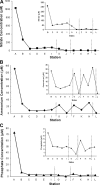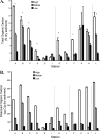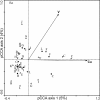Microbial community composition and denitrifying enzyme activities in salt marsh sediments
- PMID: 18978080
- PMCID: PMC2607144
- DOI: 10.1128/AEM.01221-08
Microbial community composition and denitrifying enzyme activities in salt marsh sediments
Abstract
Denitrifying microbial communities and denitrification in salt marsh sediments may be affected by many factors, including environmental conditions, nutrient availability, and levels of pollutants. The objective of this study was to examine how microbial community composition and denitrification enzyme activities (DEA) at a California salt marsh with high nutrient loading vary with such factors. Sediments were sampled from three elevations, each with different inundation and vegetation patterns, across 12 stations representing various salinity and nutrient conditions. Analyses included determination of cell abundance, total and denitrifier community compositions (by terminal restriction fragment length polymorphism), DEA, nutrients, and eluted metals. Total bacterial (16S rRNA) and denitrifier (nirS) community compositions and DEA were analyzed for their relationships to environmental variables and metal concentrations via multivariate direct gradient and regression analyses, respectively. Community composition and DEA were highly variable within the dynamic salt marsh system, but each was strongly affected by elevation (i.e., degree of inundation) and carbon content as well as by selected metals. Carbon content was highly related to elevation, and the relationships between DEA and carbon content were found to be elevation specific when evaluated across the entire marsh. There were also lateral gradients in the marsh, as evidenced by an even stronger association between community composition and elevation for a marsh subsystem. Lastly, though correlated with similar environmental factors and selected metals, denitrifier community composition and function appeared uncoupled in the marsh.
Figures








References
-
- Aelion, C. M., and J. N. Shaw. 2000. Denitrification in South Carolina (USA) coastal plain aquatic sediments. J. Environ. Qual. 29:1696-1703.
-
- Alongi, D. M. 1998. Coastal ecosystem processes. CRC Press, New York, NY.
-
- Antipov, A. N., N. N. Lyalikova, T. V. Khijniak, and N. P. L'Vov. 2000. Vanadate reduction by molybdenum-free dissimilatory nitrate reductases from vanadate-reducing bacteria. IUBMB Life 50:39-42. - PubMed
Publication types
MeSH terms
Substances
LinkOut - more resources
Full Text Sources

